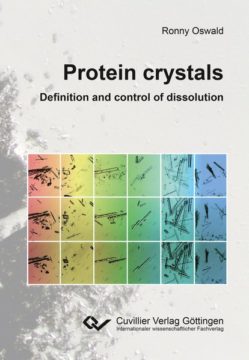Crystallization of proteins was in past decades mostly used to prepare large and highly pure crystals, to determine the structure of the protein crystals
by X-ray measurements. With the increase of industrial applications of proteins [Bre08], the desired amount of high purity proteins is increasing, too. Crystallized proteins offer an improved shelf life with a
very high degree of preservation of the protein enzyme activity. A further important advantage of protein crystallization is purification at low cost in
industrial mass production. A large number of studies on the crystallization of proteins with the aim to optimize purity, yield, shape
or activity were performed, e. g. by Durbin and Feher or McPherson. In research papers on protein crystallization, lysozyme is the
most often described protein because it is easily available and it is of fairly
low cost. In most cases, however, only the crystallization processes are investigated,
the dissolution is neglected even though dissolution of crystals is of most importance for the use of the proteins after storage.
For a better controlled use of crystallized proteins in future, it is necessary to observe and understand those dissolution mechanisms. Due to the high price most proteins could be examined in only a low quantity.
Therefore, new technologies of the examination need to be developed.
- Veröffentlicht am Dienstag 10. April 2018 von Cuvillier Verlag
- ISBN: 9783736997066
- 130 Seiten
- Genre: Natur, Sachbücher, Technik
